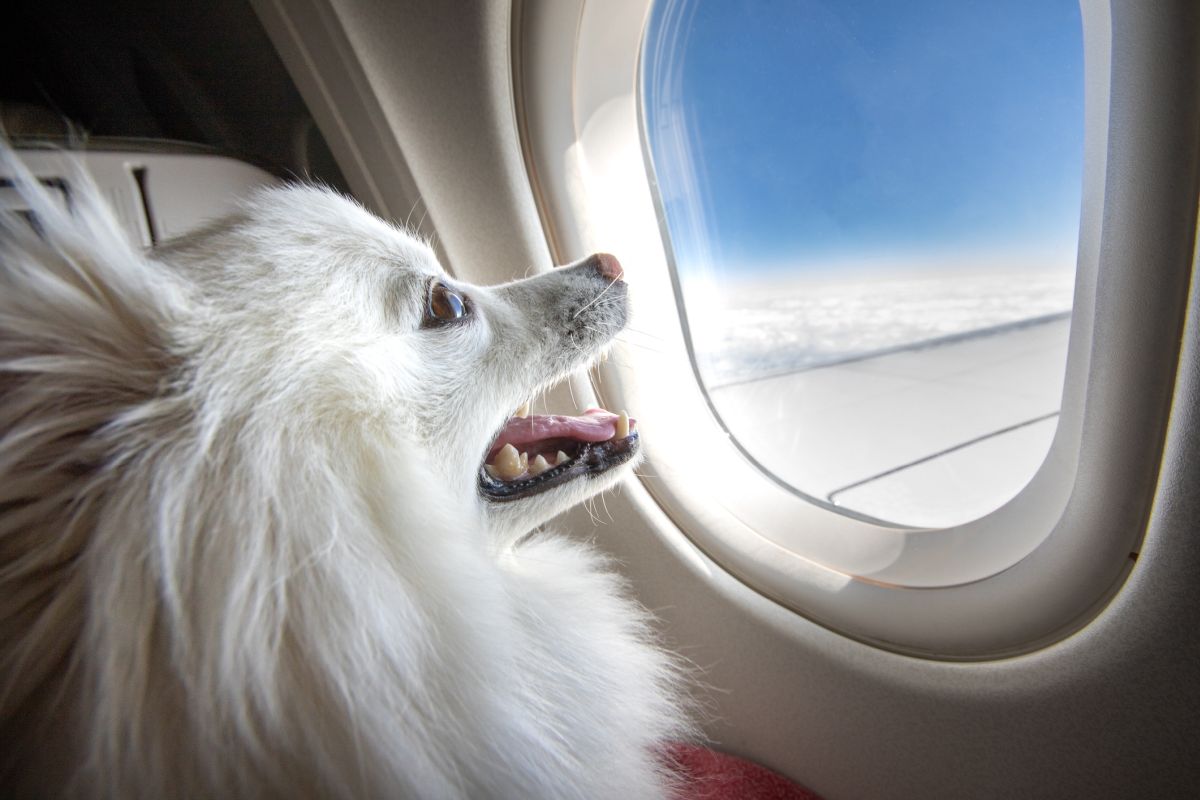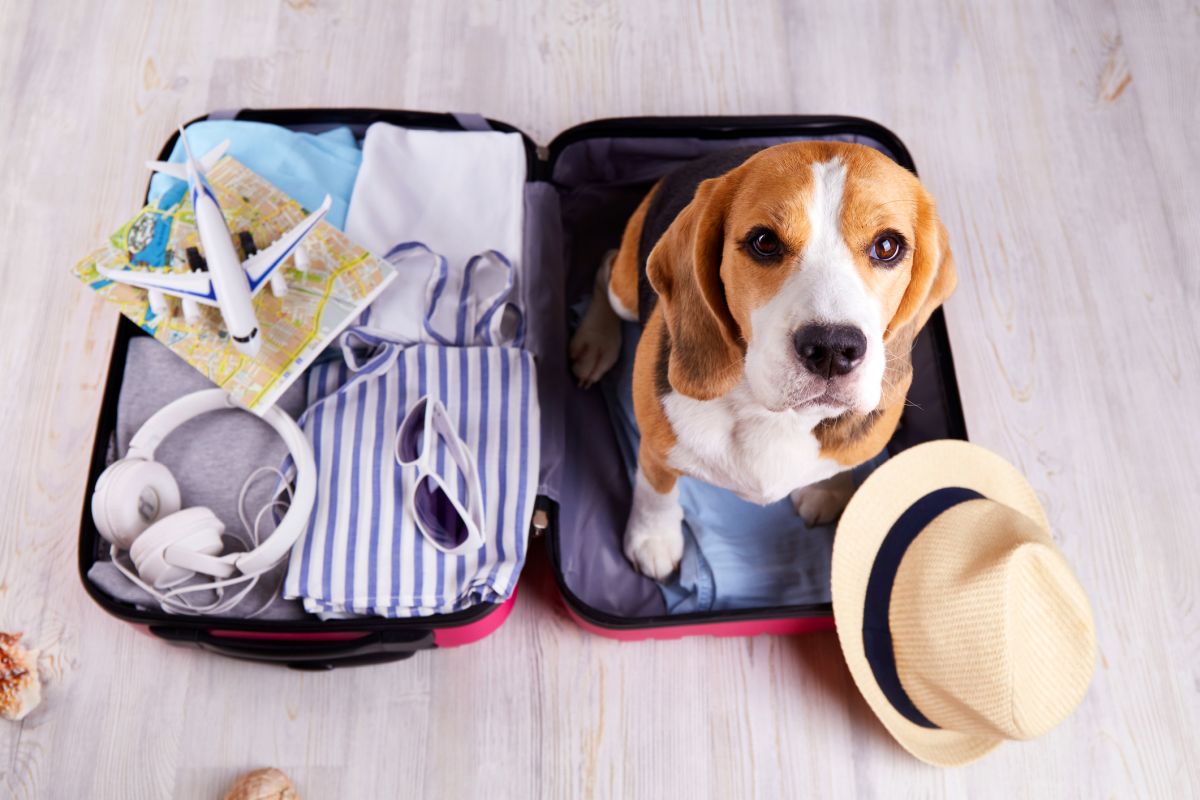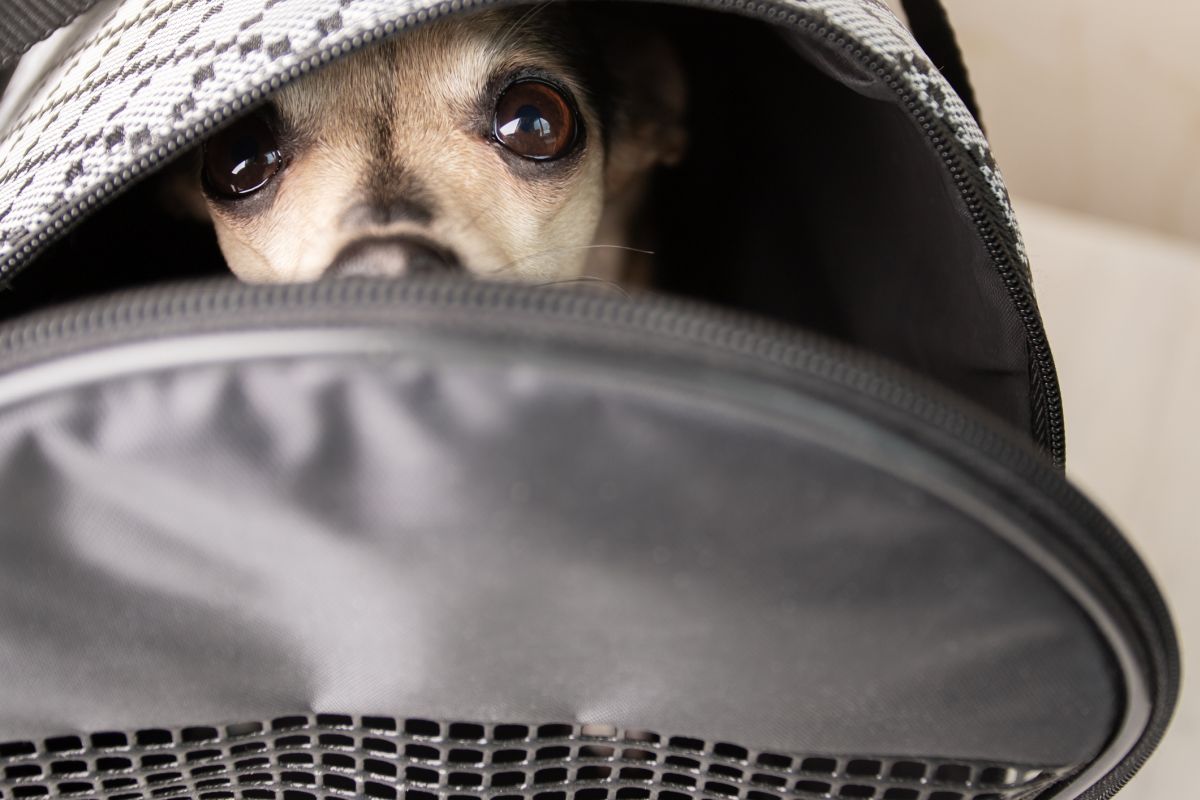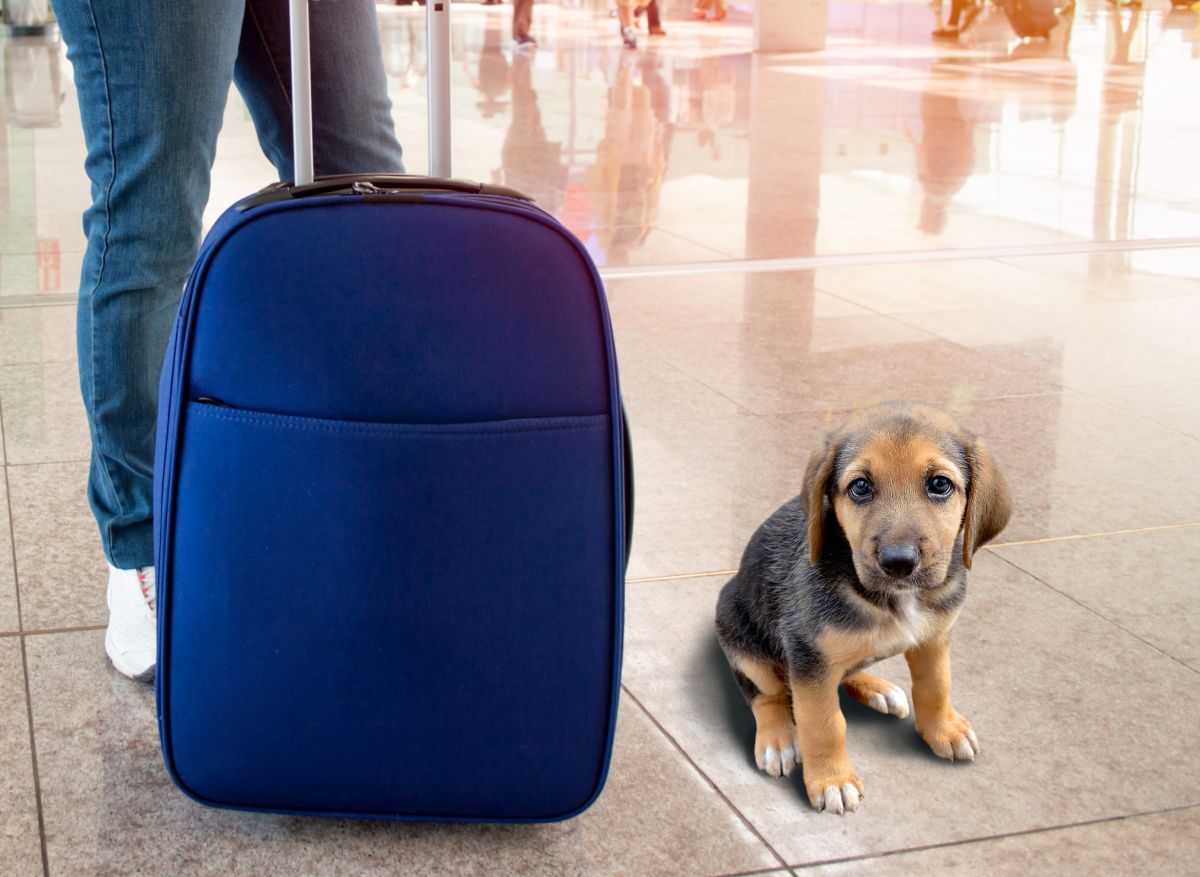Flying with a dog is an overwhelming experience if you’ve never done it before. Yet, if you take a lot of time to research the process and prepare, it will be a lot easier on both you and your furry friend.
Bringing dogs on planes can be essential if you want to go on a dog friendly vacation or if you need to move across the country. So, keep reading to learn what to expect when you fly with your dog for the first time.
Can Dogs Fly on Planes?

Yes, dogs can fly on planes, but the rules and expectations for a dog on a plane will vary based on the airline and the size of your dog. When in doubt, contact an airline to find out what they expect for dogs on flights.
How to Fly with a Dog
How to bring a dog on a plane will vary based on what type of dog you have. Some dogs are small enough to fit under the seat in front of you, allowing you to bring them in the cabin. Others are too big to go in the cabin, so they must be transported differently. All dogs on the plane must be at least 8 weeks old and at least two pounds, however, some airlines might have stricter rules.
Dog Under Airplane Seat
If your dog weighs 20 pounds or less and fits in a carrier that can slide under the seat in front of you, you can bring your dog in the cabin during a flight. Yet, the under seat dimensions vary between airlines, so you should check those restrictions before booking a flight with your dog. Your dog will need to remain in their carrier under the seat in front of you for the duration of the flight.
Dog with Checked Luggage
If your dog is too large to go in the cabin, some airlines will allow them to fly as cargo. The only exception is if they’re a service dog. You will need to put your dog in an appropriately-sized crate, and then they will go into a different area of the plane, which is pressurized and temperature-controlled. Each airline will have different rules for how to bring dogs on the plane this way.
Some airlines will have a weight limit for dogs on planes in the cargo. That weight limit will likely combine the dog’s weight and the kennel’s weight, so be sure to weigh both before going to the airport. You should also measure your dog’s kennel to make sure it’s small enough to go on your airline.
How to Prepare for Flying with a Dog

Just because a dog can fly on a plane doesn’t mean it’s always a good idea. Here are a few things you’ll need to think about before you bring a dog in an airplane.
Assess Your Dog’s Behavior
Not all dogs have the right behavior for travel. Even the best family dogs can behave poorly if not trained properly. So, if your dog is loud, restless, or reactive in public areas, they probably won’t do well on a flight. If your dog has car anxiety, there’s a good chance they’ll have plane anxiety too.
However, working on training can help your dog prepare for travel. Work on basic obedience training and socialize your dog as much as you can. Start by taking your dog to public spaces that aren’t very busy before working them up to more active areas, such as dog friendly stores or dog friendly restaurants. By being patient and consistent with your dog’s training, you can set them up for success so they can one day fly with you.
Visit Your Vet
If you’re planning on flying with dogs in the near future, you’ll want to visit your vet. Dogs need to be up-to-date on vaccinations before flying, so going to the vet is a good way to confirm that your dog has everything they need for travel. If it’s your first time flying with your dog, you can ask your vet for tips, and if your dog is anxious, they may prescribe medication for the flight. After your visit, you’ll have updated medical records to bring to the airport.
Buy an Airplane Carrier
Next, you’ll need a comfortable airplane carrier for you dog. If your dog is traveling in the cabin, the carrier needs to fit under the seat in front of you, so check your airline’s under seat size before selecting a carrier. Most pet airline carriers are 18 x 11 x 11 inches or less, and soft-sided carriers work best. The carrier should be comfortable enough for your dog to rest in it, and they should be able to easily breathe and turn around on their own. Of course, if your dog is going in the cargo space, their carrier can be much bigger and doesn’t need to be carried as far.
There are several types of dog in-cabin airplane carriers. Some have a carrying handle, others go over your shoulder, and some are backpacks. However, not all dogs like being carried and even the smallest dogs can get heavy in their bags. So, if you’re having a hard time finding a suitable airplane bag, consider one with wheels to make transportation easier for both you and your dog.
A cargo kennel should be similar to the size of your dog’s crate at home. Your canine should be able to comfortably stand up and turn around while in their kennel. Make sure your contact information is on the dog’s kennel. If the dog isn’t easily visible while inside, write “live animal” on the carrier in big letters.
Get Your Dog Used to Traveling
Once you select a dog airplane carrier, you’ll need to make sure your dog gets used to traveling in it. Carry them around in it inside your home, in your yard, or even in public spaces that allow dogs. If your dog is calm during these excursions, there’s a good chance they’ll do well during the plane ride. Yet, you can never be over-prepared, so use the carrier as much as you can before the flight. Bringing your dog to local places with you can also help them socialize and feel comfortable in new environments if they’re not already.
What to Expect at the Airport When Flying with a Dog

Every airline and airport operates a little differently, but below are some general tips for flying with your dog for the first time.
Before Arriving
Whether your dog is in the cargo or cabin, make sure they have an identification tag and microchip. Both should have your up-to-date contact information. It’s unlikely that they’ll be separated from their carrier, but it’s always better to be safe than sorry.
Then, before you go into the airport, let your dog go to the bathroom outside. There are often dog relief areas inside, but not all dogs feel comfortable peeing on the fake grass. So, it’s a good idea to give them an opportunity to do their business in advance just in case. For dogs going with checked luggage, they won’t have a chance to go to the bathroom again once you hand over their kennel.
If your dog is flying in the cabin with you, make sure you bring some paper towels. Even if your dog is well-behaved and potty trained, accidents can happen. If your dog pees, poops, or vomits, it’s your job to clean it up. Having paper towels on you will make clean up easier.
Going Through Security
Dogs going in the cabin will need to go through security with you. Most airports allow passengers with dogs to go through the same line as people with wheelchairs so you don’t hold up the regular line. If you’re unsure which line to go in, ask an employee.
When you get near the front of the line, you should take your dog out of their carrier and hold them in your arms. Send their carrier through the x-ray machine. Then, wait for an employee’s instructions on where to go next. Most of the time, they will have you walk through security while holding your dog, and then an employee will test your hands on the other side. Once you’ve gone through, you’ll need to put your dog back in their carrier before proceeding to your gate.
On the Flight
Once you’re on the flight, you can sit back and relax. Hopefully, your dog will be able to as well. Most airlines require your dog to say under the seat for the entire flight with their carrier completely closed. However, if your dog is anxious, the flight attendants might not mind if you open the carrier slightly so you can pet your dog or let your dog peek out. Most dogs will be a little nervous when the plane takes off and lands, but if they know you’re there, that’ll help them calm down.
Pet Policies for Biggest Airlines

Most airlines allow a limited number of dogs on their flights, but they all have different pet policies. Most airlines charge $95 to $125 to bring a pet in the cabin. However, a dog in the cargo could cost anywhere from $150 to $1,000.
Below are the pet policies for a few popular pet friendly airlines to help you decide which one to choose.
United
On United Airlines, a hard-sided pet carrier must be 17.5 x 12 x 7.5 inches or smaller and a soft-sided carrier must be 18 x 11 x 11 inches or smaller. There is a $125 dog plane ticket fee for each way. You’ll need to contact the airline for details about checked pets. Click here for United’s full pet policy.
American
American recommends soft-side kennels for dogs, but hard-side ones are still allowed. Soft-sided carriers must be 18 x 11 x 11 inches or smaller while hard-sided carriers must be 19 x 13 x 9 inches or smaller. If you’re checking a pet, the combined weight of the dog and kennel cannot exceed 100 pounds. Carry-on pets cost $125 per carrier while checked pets vary in cost. Click here for American’s full pet policy.
Southwest
A pet carrier on Southwest Airlines must be 17 x 10 x 9.5 inches or smaller. The pet fee is $95 each way, unless you’re traveling between Hawaiian islands, then it’s $35. Southwest doesn’t allow pets as checked baggage. Click here to see all the pet info for Southwest flights.
Other Airlines
The best way to find out the pet policy on each airline is to check that airline’s website. BringFido.com also has a list of the pet policies for most airlines. So, be sure to check those regulations before planning to fly with your dog.
Frequently Asked Questions
Before you plan on flying with your dog, here are some questions you might be wondering.
Can I Buy an Extra Seat for My Dog on a Plane?
No, you cannot buy a seat for your dog. All pets must go under the seat in front of you. Even service dogs must sit on the floor in front of their handler.
Where Can a Dog Go to the Bathroom on a Long Flight?
The only places dogs can go to the bathroom on a flight are on pee pads, either in their carrier or in the bathroom. So, if the flight isn’t too long, you should make sure they go to the bathroom before boarding the flight.
Can Emotional Support Dogs Fly for Free?
No, emotional support dogs cannot fly for free because they don’t perform specific tasks like service dogs. Emotional support animals used to be allowed on some airlines for free, but the rules changed since many people were pretending their dogs were ESAs.
Preparing for Flying with a Dog
Flying with a dog can be an overwhelming experience if you’ve never done it before. Hopefully, these tips helped you get an idea for what to expect. If your dog is generally calm, traveling with dogs should be a breeze. Yet, if your pup is anxious or disobedient, you’ll need to do a lot of preparing before they’ll be ready to fly.
Before you book a flight with your dog, make sure you check your airline’s specific rules for pets so your trip can go smoothly.
